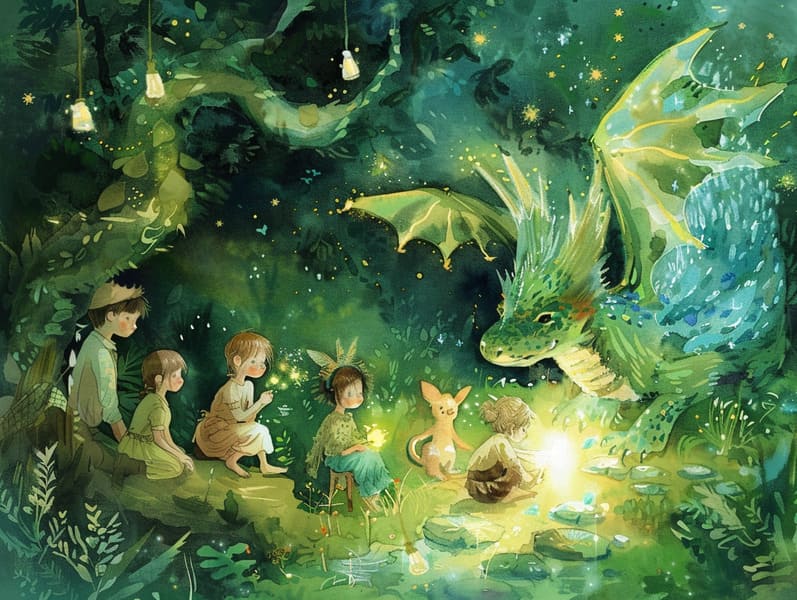The Evolution of Children's Fairy Tales with the Unfading Grandeur.
The Evolution of Children's Fairy Tales with the Unfading Grandeur.
Blog Article

Fairy tales have ancient roots. These narratives have been narrated from one generation to the next far before they were ever documented. They arose from a variety of cultures, including Middle Eastern traditions. They were initially shared among grown-ups, often carrying themes and messages mirroring the societal norms and beliefs of the time.
The renowned Brothers Grimm, Jacob and Wilhelm (the Grimm brothers), were among the first to gather many of these beloved stories. Their collection, "Grimm's Story Collection," included tales like "The Little Glass Slipper," "The Bread Crumb Trail," and "Snow-White and Rose-Red," which have since become classics in the world of famous fairy tales. Similarly, H. C. Andersen's imaginative narratives, such as "The Little Mermaid," and "The Little Duckling," have won hearts worldwide, cementing their place in the pantheon of classic fairy tales.
Though they are centuries old, traditional fairy tales remain as pertinent as ever, especially as children's night stories. These delightful tales are now available in multiple formats, including vibrantly illustrated books, enchanting animations, and online fairy tales.
Their continued relevance can be ascribed to several charming aspects:
Important Morals: Timeless fairy tales often whisper important moral lessons. Narratives like "The Boy Who Cried Wolf" teach the benefit of truth, while "The Race of the Tortoise and the Hare" illustrate the qualities of determination and unassuming nature. These narratives offer young ones clear distinctions between correct and incorrect, guiding their moral compass in a kind yet lasting way.
Kindness and Comprehension: Ancient fairy tales frequently include heroines facing trials and tribulations, stimulating children to feel with their struggles and back their triumphs. For instance, "Beauty and Her Beast" illustrates the benefit of seeing beyond the surface to acknowledge the inner being of a being, strengthening sympathy and appreciation.
Cultural Comprehension: Many traditional fairy tales are steeped in the cultural contexts from which they arose. Reading these tales can provide illuminating insights into different beliefs, developing a sense of world insight and knowledge.
Creativity and Imagination: The magical elements in timeless fairy tales—enchanted lands—fire up children’s visions. These fairy tales carry readers to enchanted realms, awakening innovative dreams and a sense of amazement that lasts a lifetime.
Timeless fairy tales are not only spellbinding but also educational. They function as fascinating tools in advancing various cognitive and emotional skills in young readers. When traditional fairy tales are read aloud, they strengthen speech development by teaching new phrases and elaborate sentence structures. This practice also advances auditory skills and attention, as kids concentrate deeply, eager to see what happens next.
Furthermore, debating the themes and characters of timeless fairy tales can foster logical thinking and reasoning skills. Young readers are led to find patterns, anticipate outcomes, and get cause and effect. These discussions also encourage kids speak out their thoughts and feelings, boosting their emotional intelligence.
In today’s digital age, the existence of online fairy tales has made these tales more accessible than ever. Online platforms and online apps give wide arrays of popular fairy tales that can be looked at or listened via anytime, anywhere. Fairy here tales voiced are particularly common, giving an immersive method for young ones to be a part of these spellbinding stories. Audiobooks and voiced videos carry characters and settings to life, often paired with charming soundtracks and soundtracks that boost the tale experience.
The lasting allure of traditional fairy tales lies in their ability to alter to changing times while holding onto their core values. Contemporary retellings of these narratives often incorporate more different figures and modern settings, making them understandable to today’s audience. However, the basic principles of gallantry, sympathy, and justice remain unchanged, continuing to affect young listeners of all ages.
Ancient fairy tales also offer a sense of protection and homeliness. They supply a coherent narrative with a evident beginning, middle, and end, often winding up with the finalization of conflicts and the triumph of honesty over deceit. This foreseeability can be solacing for young ones, giving a sense of sturdiness in an variable world.
Traditional fairy tales continue to captivate and enlighten new generations, maintaining their beauty and impact in modern society. As bedtime stories for kids, they deliver up a perfect blend of charm and understanding, developing moral values, empathy, and creativity. The abundance of free fairy tales online and the sought after status of fairy tales read aloud ratify that these traditional stories remain available to new generations.
By perpetuating and conveying these fairy tales, we continue to praise the rich tapestry of tales and cultural heritage. Whether you are delving into a beautifully illustrated book, exploring a online collection, or listening on an narrated book, the majesty of Grimm's fairy tales is always within reach. These narratives point out of the invariable force of tales and its ability to link us across epochs and places.
Whether you are exploring a artistically illustrated book, perusing a internet library, or playing an read-aloud book, the delight of traditional fairy tales is always within reach.
These tales highlight of the perpetual spell of tales and its ability to connect us across eras and regions, casting a charm that delights and instructs alike.